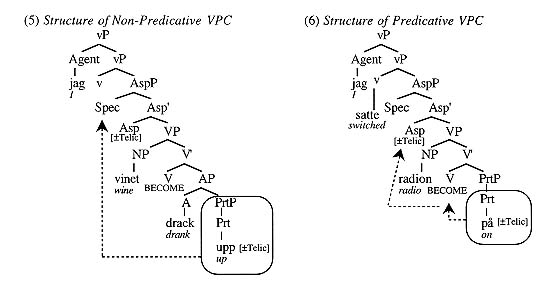(1c) Mannen har (opp) drukket (opp) vinen (Nor)
(2a) John switched (on) the TV (on).
(2b) Vi¹ hentum (út) hundinum (út). (Icl)
(2c) Vi kastet (ut) hunden (ut). (Nor)
It is generally held that the word in Swedish VPCs is strictly
V-Prt-NP (Holmberg & Platzack 1995), (3a) and (4a). However,
if the full DP object of (3a) and (4a) is replaced by a pronoun,
then (3b) is remains bad while (4b) improves dramatically. Also,
in (4) the main verb can be replaced by the light verb hade
'had', without changing neither grammaticality nor interpretation,
(4c); this is impossible in (3c). Next, in (4) passive can apply
without forcing the particle to surface as prefix, (4d), but not
in (3d). In (3) the particle must surface as prefix in passive,
(3e). Hence, a 'D-structure' object can not surface to the left
of the particle in (3b, 3e). Finally, in the particle in (4) can
be used as the predicate in a copula construction, whereas the
particle in (3) can not, (3f) and (4f). On the basis of this distinction,
I call the particle in (3) non-predicative, and the one
in (4) predicative.
| Non-Predicative VPCs
(3a) Jag drack (upp) vinet (*upp)
(3b) Jag drack (upp) det (*upp)
(3c) *Jag hade upp vinet.
(3d) *Vinet blev drucket upp
(3e) Vinet blev upp-drucket.
(3f) *Vinet är upp. | Predicative VPCs
(4a) Jag satte (på) TVn (*på)
(4b) Jag satte (på) den (på)
(4c) Jag hade på TVn
(4d) TVn blev satt på
(4e) TVn blev på-satt
(4f) TVn är på |
The Proposal. This paper argues predicative and non-predicative VPCs are structurally distinct. Adopting Baker's (1997) highly articulated VP, I claim that the lexical verb in a non-predicative VPC originates as A (which conflates with V) and the particle is the structural complement of A, (5). In predicative VPCs, the lexical verb is essentially the spell out of MANNER and CAUSE (Hale & Keyser 1993, Levin & Rapoport 1989), suggesting that it originates as a light verb in the upper v ((3c-4c)). The predicative particle is the complement of the lower V, which is phonologically empty, but hosts a lexical operator BECOME/GO, as in (6) (Baker 1997, Travis 1997).
Moreover, it is a well known fact that all VPCs have consequences
for the aspectual properties of an event, typically related to
telicity (Tenny 1994, Travis 1997, Keyser & Roeper 1992).
Following Travis (1991, 1997), AspP intervenes between VP and
vP (Chomsky 1995, Kratzer 1996 etc) and Asp_ hosts a feature [±telic],
in addition to the case-feature [accusative]. Assuming that the
feature [±telic] in Swedish is strong in the sense of Chomsky
(1995), the particle is forced to move into AspP in order to check
off the feature. A non-predicative particle moves into
SpecAspP, thus a licit checking relation obtains. This
also has the effect of blocking a pronominal object from raising
into SpecAspP (3b).In a predicative VPC, the particle head-moves
into V, whereupon [V Prt [VØ]]
raises to Asp_, where checking now can obtain via the head-head
relation. As a consequence, SpecAspP is empty and a pronominal
object may raise into this position (4b).

Assuming now that the theme must raise through SpecAspP also in passives, the fact that a predicative particle may be stranded follows straightforwardly, since the particle does not target SpecAspP. However, in non-predicative VPCs, both NP and PrtP compete for SpecAspP. The situation can be resolved, since A governs Prt, and therefore Prt can incorporate into A (Baker 1988, Travis 1984), thus surfacing as prefix, assuming left-adjunction only (Kayne 1993). A conflates with V and V raises to Asp and hence a checking relation obtains between Asp and Prt.. Crucially, SpecAspP is now available as an intermediate landing site for the theme.
Extensions. The theory outlined provides a straightforward
way to capture the various behaviors of VPCs found among the Scandinavian
languages and English. Western Norwegian (Svenonius 1996), behaves
essentially as Swedish, which suggest that the feature [±telic]
is strong, and thus forcing incorporation in passivized or passive-like
non-predicative VPCs, (7).
(7a) *Me prøvde[ å få [ slaktet skore opp]].
(W.Nor)
(7b) Me prøvde [ å få [slaktet opp-skore]].
(W.Nor)
On the other hand, in Standard Norwegian, Icelandic and English, the feature is optionally strong, hence allowing (1) and (2). These languages do not allow particle-incorporation in passives. I assume that this blocked by economy considerations, since incorporation involves more overt movement than non-incorporated ones.
Finally, Danish allows only the word order V-NP-Prt, and
particles never surface as prefixes. This suggest then that [±telic]
is weak in this language.
(8) Boris skrev (*under) kontrakten (under). (Dan)
< Back to List of Abstracts | Back to PLC23 Home Page >
About the PLC23 Committee
Previously held Penn Linguistics Colloquium: PLC22 (1998), PLC21 (1997)
Penn Department of Linguistics
University of Pennsylvania